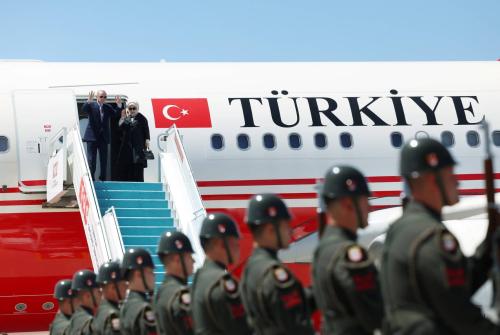Forty years ago this week, Richard Nixon undertook his historic visit to China that ended over two decades of estrangement between the United States and the People’s Republic of China. In a stroke the trip reshaped the international geopolitical map, altered the balance of the Cold War, jolted alliances of both our countries in East Asia, and laid the groundwork for China’s opening to the world.
At the core of opening to China was a decision by Nixon and Mao Zedong to put to the side the issues of values and ideology that had kept us apart since the Communists took power in 1949 and to concentrate instead on common interests. This has been the fundamental underpinning of U.S.-China relations since then, even at times when leaders of an ideological bent were at the helm in one country or the other. For example, the relationship weathered some difficulty as Zhou Enlai became incapacitated and before Deng Xiaoping took charge, when the so-called “Gang of Four” were dominant in Beijing. It went into the freezer in the wake of the Tiananmen incident in 1989, when values again came to the fore in American perspectives on the relationship.
How does the relationship stand today, forty years after Nixon’s visit?
The basic bargain to put ideology and values to the side has substantially held. Both U.S. political parties have accepted it, with varying degrees of discomfort from time to time. In the wake of the Iraq war, enthusiasm among the American population for wars or crusades on behalf of democracy has waned, though the Arab Spring has revived the sense that democracy everywhere deserves visible American support. Notwithstanding, no one has attempted to link Chinese human rights behavior to the core relationship since an abortive attempt by the Clinton administration to do so in 1993. It is unlikely that anyone will come up with a new formula to do so, with the relationship increasingly less one-sided in terms of leverage. Most Americans believe that it is essential for China to move toward democracy and human rights protection, but they also understand that our ability to affect that evolution is small.
The common interests on which Nixon and Mao sought to cooperate were international issues. In their day, the dominant ones were Vietnam and Indochina, Korea, south Asia, and resistance to Soviet expansionism. Since then, up to and including the Obama administration, American presidents have sought to work with the Chinese on the major international issues, either in the United Nations Security Council or elsewhere where the Chinese have influence.
The record on such issues in recent years has been mixed. The United States and China have agreed on opposition to the Iranian and North Korean nuclear weapons programs, but have differed on tactics to reverse them. They have worked together to preserve peace in the Korean peninsula and in the Taiwan Strait. They see the Arab Spring, and more recently the Syrian uprising, through very different lenses, which will be a source of tension as the region remains in turmoil and the forces of change and status quo come into violent conflict. We have a common interest in preventing Pakistan from becoming a long-term source of instability and base for terrorism, but differing perspectives on Pakistan’s relationship with India. The good news is however deep our differences on some of these issues, none has led, or shows signs of leading, to conflict between us.
The element in the relationship that is unrecognizable from the time of Nixon’s trip, of course, is the economic. The U.S. business community has been the anchor of U.S.-China relations for the last 30 years, as we have built up an annual trade relationship of over $500 billion, with huge U.S. investments in China and growing Chinese investment here. The business community, however, is now divided in the face of Chinese competition, some conducted in ways in conflict with Western norms. Pressure inside the United States for strong action against Chinese economic practices has been building. In the years ahead economic frictions may prove a greater challenge to a smooth relationship than the international security issues that have been the historic core of U.S.-China relations.
Finally, there is the emerging risk of bilateral security competition, based either on real or perceived threats from the other. Many Americans look at China and see a People’s Liberation Army growing at 15% per year, a dictatorial government without the constraint of domestic accountability, a system opaque about its strategic intentions and doctrines, a claimant to Taiwan and the South China Sea, and a modernizing nuclear power. Many Chinese look at the United States and see a country seeking to contain its rise by military alliances, surveillance, and modernization along its periphery, preparation for a potential war, support for China’s continuing division, and efforts to promote regime change. Management of this security dilemma on both sides will require cool-headedness, leadership, and courage against domestic forces who might find benefit in a new cold war.
The biggest challenge, as Nixon understood before his death in 1994, was whether the United States and China could sustain the relationship that he helped launch in the absence of a common enemy, the Soviet Union. Nixon believed we could, and should. He was right. But leaders on both sides will need to identify and work together on common interests, internationally and bilaterally, more effectively than they have since 1990 if we are not to be overwhelmed by the security dilemma, economic clash, and ideology. This may not sound like a task as heroic as Nixon’s trip to China, which spawned an opera, but it may be as important to the prospects of continued peace for the next forty years as Nixon’s visit.
The Brookings Institution is committed to quality, independence, and impact.
We are supported by a diverse array of funders. In line with our values and policies, each Brookings publication represents the sole views of its author(s).



Commentary
China and the United States: Nixon’s Legacy after 40 Years
February 23, 2012